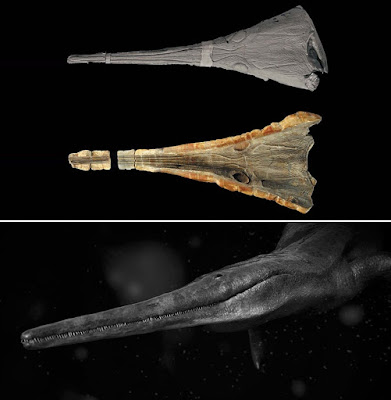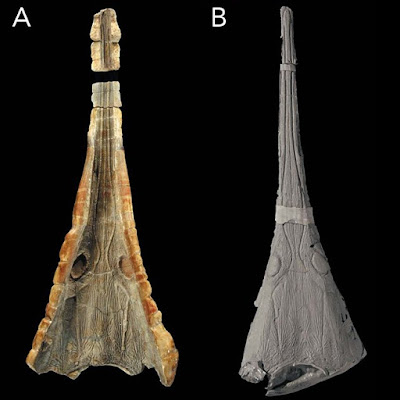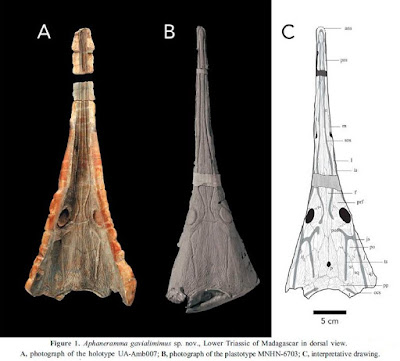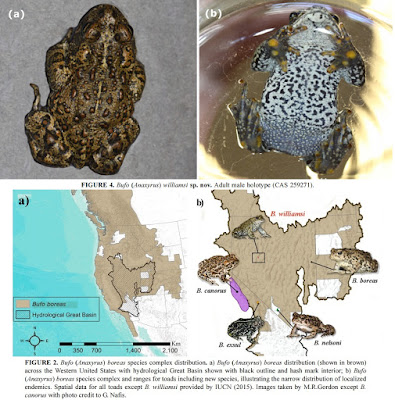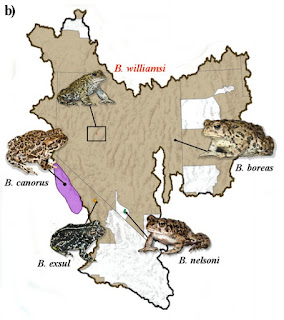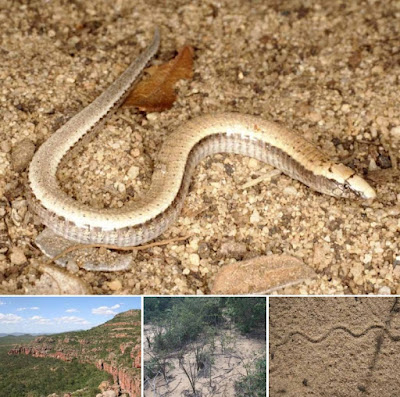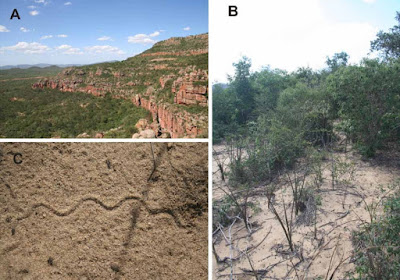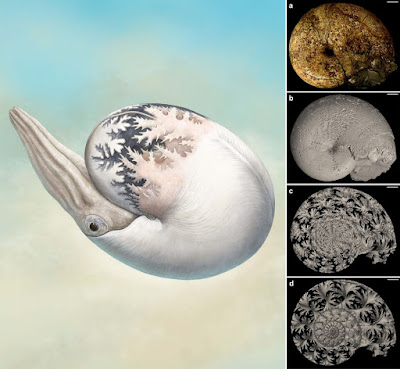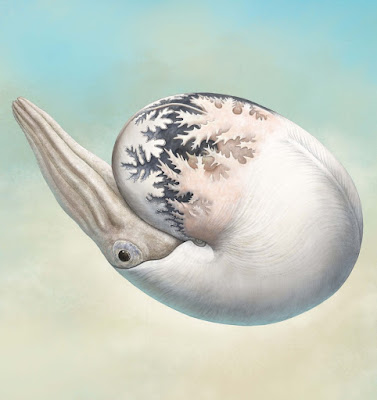[Most Recent Entries] [Calendar View]
Thursday, July 6th, 2017
| Time | Event | ||||||||
| 1:05a | [Paleontology • 2017] Aphaneramma gavialimimus • A New Extreme Longirostrine Temnospondyl from the Triassic of Madagascar: Phylogenetic and Palaeobiogeographical Implications for Trematosaurids
Abstract Trematosaurids form a very large and remarkable clade of Triassic tetrapods (Temnospondyli: Stereospondyli) with a worldwide geographical distribution. Compared with specimens from Europe, Australia or North America, they remain relatively scarce in African rocks, where they are mainly known in the Early Triassic of Madagascar and South Africa. Longirostrine trematosaurids were only known from Madagascar, represented by the genus Wantzosaurus. However, we describe herein a new species of the longirostrine trematosaurid Aphaneramma, Aphaneramma gavialimimus sp. nov., from the Olenekian (Lower Triassic) of Madagascar. This genus was previously known from the Early Triassic of Europe and Asia. Based on a new nearly complete skull, the new species is characterized by a premaxilla-nasal suture anteriorly directed, not contacting the nostrils; choanae completely included within the palatines; the ventral opening of the orbits in the anterior part of the interpterygoid vacuities; a very elongated nasal covering more than 50% of the prenarial length; and an anteriorly widened cultriform process. Aphaneramma gavialimimus sp. nov., with a skull length of about 40 cm, may be one of the largest known trematosaurids. Its inclusion in a new phylogenetic analysis confirms its close affinities with the North American genus Cosgriffius, and clarifies the relationships of trematosaurids in general and lonchorhynchines in particular. The new species also increases the palaeobiodiversity of marine trematosaurs in Gondwana and allows discussing their apparently rapid cosmopolitanism just after the great Permian–Triassic mass extinction. Keywords: Lonchorhynchinae, Olenekian, palaeobiogeography, Permian–Triassic mass extinction
Systematic palaeontology Temnospondyli Zittel, 1888 Stereospondyli Zittel, 1888 Trematosauria Romer, 1947 sensu Yates & Warren, 2000 Trematosauroidea Säve-Söderbergh, 1935 sensu Schoch, 2013 Family Trematosauridae Watson, 1919 Subfamily Lonchorhynchinae Säve-Söderbergh, 1935 sensu Steyer, 2002 Aphaneramma Smith Woodward, 1904 Type species. Aphaneramma rostratum Smith Woodward, 1904 (D ‘Lonchorhynchus obergi’ Wiman, 1910) from the early Olenekian of the Sticky Keep of Spitsbergen, Vikinghøgda Formation, Svalbard Archipelago, Norway. Definition. All taxa sharing a more recent common ancestor with Aphaneramma rostratum than with Cosgriffius campi. Aphaneramma gavialimimus sp. nov. Etymology. Imitates a gharial (Gavialis gangeticus), due to the general shape similarity with this hyper-longirostral taxon.
Josep Fortuny, Stéphanie Gastou, François Escuillié, Lovasoa Ranivoharimanana and J.-Sébastien Steyer. 2017. A New Extreme Longirostrine Temnospondyl from the Triassic of Madagascar: Phylogenetic and Palaeobiogeographical Implications for Trematosaurids. Journal of Systematic Palaeontology. DOI: 10.1080/14772019.2017.1335805 | ||||||||
| 6:00a | [Herpetology • 2017] Bufo (Anaxyrus) williamsi • A New Cryptic Toad Species (Bufonidae: Bufo (Anaxyrus)) discovered in Northern Nevada; A Diamond in the Rough Desert Shrublands of the Great Basin in the Western United States Abstract We describe a new species of toad from the Great Basin region of northern Nevada belonging to the Bufo (Anaxyrus) boreas species complex. This cryptic species was detected through genetic analyses of toad populations sampled throughout the Great Basin and the morphological evidence was quantified through extensive sampling of live toads within the region. The new species has the smallest body size in the species complex, and can be further diagnosed from other species in the complex by its large tibial glands and unique coloration. The known distribution of the new species is restricted to an area less than 6 km2 in Dixie Valley, Churchill Co., Nevada. The Great Basin is an arid region where aquatic resources are both rare and widely scattered, making habitat suitable for anuran populations highly vulnerable to anthropogenic change. The habitat occupied by this newly described species is threatened by the incipient installation of geothermal and solar power development projects that require the water that defines its habitat. Keywords: Amphibia, Bufo (Anaxyrus) williamsi sp. nov., Dixie Valley Toad, Western Toad, Bufo(Anaxyrus) boreas species complex, cryptic species, morphology, new species, conservation, geothermal Bufo (Anaxyrus) williamsi sp. nov. Dixie Valley Toad Diagnosis. Bufo (Anaxyrus) williamsi is distinguishable from B. boreas by a combination of diagnostic morphological characters (Fig. 4; Table 1, Table 2), genetic evidence (Fig.3, Fig. 6), and localized distribution (Fig. 2b). Bufo (Anaxyrus) williamsi is distinct from B. boreas by: a small adult body size (SVL is more than 2.5 cm smaller than B. boreas; Table 1); significantly, but modestly, larger, closely-set eyes, and smaller head (Table 2); statistically and perceptibly larger tympanum, and shorter hind limbs; conspicuously large and elevated tibial glands; and distinctive color pattern (Fig. 4a, Fig. 4b). Etymology. The specific epithet is in tribute to Robert Williams, former Field Supervisor of the U.S. Fish and Wildlife, whose Herculean efforts on behalf of the fauna of Nevada and California were critically important in discovering additional biodiversity of anurans in the Great Basin, and in focusing on the needs to provide protection to the rare and imperiled fauna, and the ecosystems upon which they depend, in Nevada and California. The Dixie Valley toad would not have been discovered without the efforts of this courageous public servant. Distribution. Bufo (Anaxyrus) williamsi is found only within wetlands of limited extent fed from artesian springs on the western edge of the Dixie Valley Playa, east of the Stillwater Range in Dixie Valley, NV (Fig. 2b). Natural history. Bufo (Anaxyrus) williamsi is restricted to the spring fed-wetland habitat along the western edge of the Dixie Valley playa. Similar to other toads in the B. boreas complex (except perhaps B. exsul, which is more aquatic), the terrestrial B. williamsi is typically nocturnal, emerging at dusk, and can be found in moist vegetation or in very still, shallow water with very little vegetation canopy. Dixie Valley experiences extreme temperature fluctuations between day and night temperatures, as well as season-to-season extremes, characteristic of cold desert ecosystems. Michelle R. Gordon, Eric T. Simandle and C. R. Tracy. 2017. A Diamond in the Rough Desert Shrublands of the Great Basin in the Western United States: A New Cryptic Toad Species (Amphibia: Bufonidae: Bufo (Anaxyrus)) discovered in Northern Nevada. Zootaxa. 4290(1); 123–139. DOI: 10.11646/zootaxa.4290.1.7 | ||||||||
| 3:05p | [Herpetology • 2008] Scriptosaura catimbau • A New Genus and Species of Eyelid-less and Limb Reduced Gymnophthalmid Lizard (Squamata, Gymnophthalmidae) from northeastern Brazil
Abstract Scriptosaura catimbau, a new genus and species of elongate, fossorial, sand swimming eyelid-less gymnophthalmid lizard is described on the basis of specimens obtained at Fazenda Porto Seguro, municipality of Buíque, State of Pernambuco, in the Caatingas of northeastern Brazil. The type locality is entirely included within the area of the recently created Parque Nacional do Catimbau. The new lizard lacks external forelimbs, has rudimentary styliform hindlimbs and is further characterized by the absence of prefrontal, frontal, frontoparietal and supraocular scales, and by having one pair of chin shields. A member of the Gymnophthalmini radiation, the new genus is considered to be sister to Calyptommatus from which it differs externally by the absence of an ocular scale and absence of an enlarged temporal scale. Key words: Scriptosaura catimbau, new genus, Gymnophthalmidae, taxonomy, Catimbau Nacional Park, Pernambuco State, Brazil, Caatingas
Scriptosaura, gen. nov. Definition: An elongate and short tailed gymnophthalmid lacking an ear opening and eyelid. Forelimbs absent, hindlimbs rudimentary, styliform, ending in a short apical scale; nail absent. Frontonasal single; prefrontals, frontal, frontoparietals, supraoculars, and loreal absent. Parietals longer than wide, contacting frontal. Nostril in the center of nasal. Collar fold absent. One pair of chin shields. Dorsal scales cycloid anteriorly, posteriorly smooth, hexagonal, keeled and slightly mucronate, in regular transverse series; lateral scales enlarged, smooth. Ventral scales smooth, in four regular transverse series, the external ones wider. Males with four preanal pores, absent in females. Etymology: From the Latin “scriptor” = writer, and “saura” = lizard in reference to the sand tracks left by this sand swimming species. The tracks are in the origin of its popular name (escrivão = public writer) which is also attributed to other similar sand swimming lizards like those of the related genera Calyptommatus and Nothobachia. Scriptosaura catimbau, sp. nov. Etymology: A noun in apposition, in reference to the type locality, Parque Nacional do Catimbau.
Resumo: Scriptosaura catimbau, um novo gênero e espécie arenícola de lagarto gimnoftalmídeo fossorial com corpo alongado e sem pálpebra é descrito com base em espécimes obtidos na Fazenda Porto Seguro, município de Buíque, estado de Pernambuco, nas Caatingas do nordeste brasileiro. A localidade tipo está inteiramente incluída no recentemente criado Parque Nacional do Catimbau. O novo lagarto, sem membros anteriores e com membros posteriores reduzidos a apêndices estiliformes caracteriza-se pela ausência de prefrontal, frontal, frontoparietal e supraocular e por apresentar um único par de escudos pós-mentais. O novo gênero pertence à tribo Gymnophthalmini e é considerado irmão de Calyptommatus do qual difere externamente pela ausência de escama ocular e de uma escama temporal muito aumentada, características do último gênero. Palavras chave: Scriptosaura catimbau, gênero novo, Gymnophthalmidae, taxonomia, Parque Nacional do Catimbau, Estado de Pernambuco, Brasil, Caatingas Miguel Trefaut Rodrigues and Ednilza Maranhão Dos Santos. 2008. A New Genus and Species of Eyelid-less and Limb Reduced Gymnophthalmid Lizard from northeastern Brazil (Squamata, Gymnophthalmidae). Zootaxa. 1873; 50–60. | ||||||||
| 4:00p | [Paleontology • 2016] Suture Pattern Formation in Ammonites and the Unknown Rear Mantle Structure
Abstract Ammonite shells have complex patterns of suture lines that vary across species. The lines are formed at the intersection of the outer shell wall and the septa. The wavy septa can form if the rear mantle of the ammonite, which functions as the template, has a complex shape. Previous hypotheses assumed that the rear mantle is like a flexible membrane that can be folded by some physical force. The elucidation of the mechanism of septa formation requires that the detailed shape of the septa should be known. We developed a new protocol of X-ray micro-computed tomography (CT) and obtained high-resolution three-dimensional (3D) images of the septa of the Upper Cretaceous ammonite Damesites cf. damesi. The obtained image suggested that the wavy and branched structures of the rear mantle grew autonomously. We found that some extant sea slugs have branched structures and showed similar shape and growth sequence as those in fossils, suggesting that the mantle of molluscs basically has the potential to form branched projections. Based on the characteristics of the obtained 3D structure, we explain how ammonites might have formed the complex suture patterns. Shinya Inoue and Shigeru Kondo. 2016. Suture Pattern Formation in Ammonites and the Unknown Rear Mantle Structure. Scientific Reports. 6; 33689. DOI: 10.1038/srep33689 |
| << Previous Day |
2017/07/06 [Calendar] |
Next Day >> |
